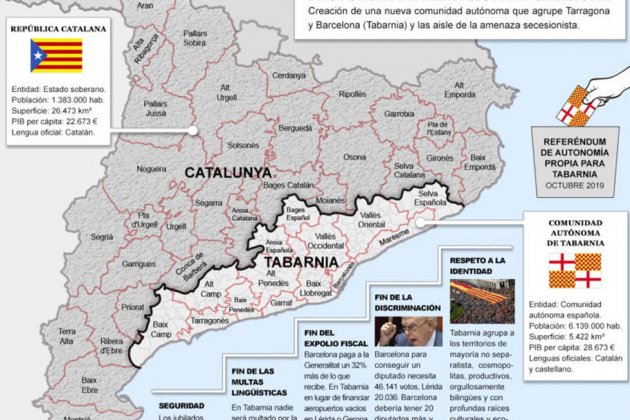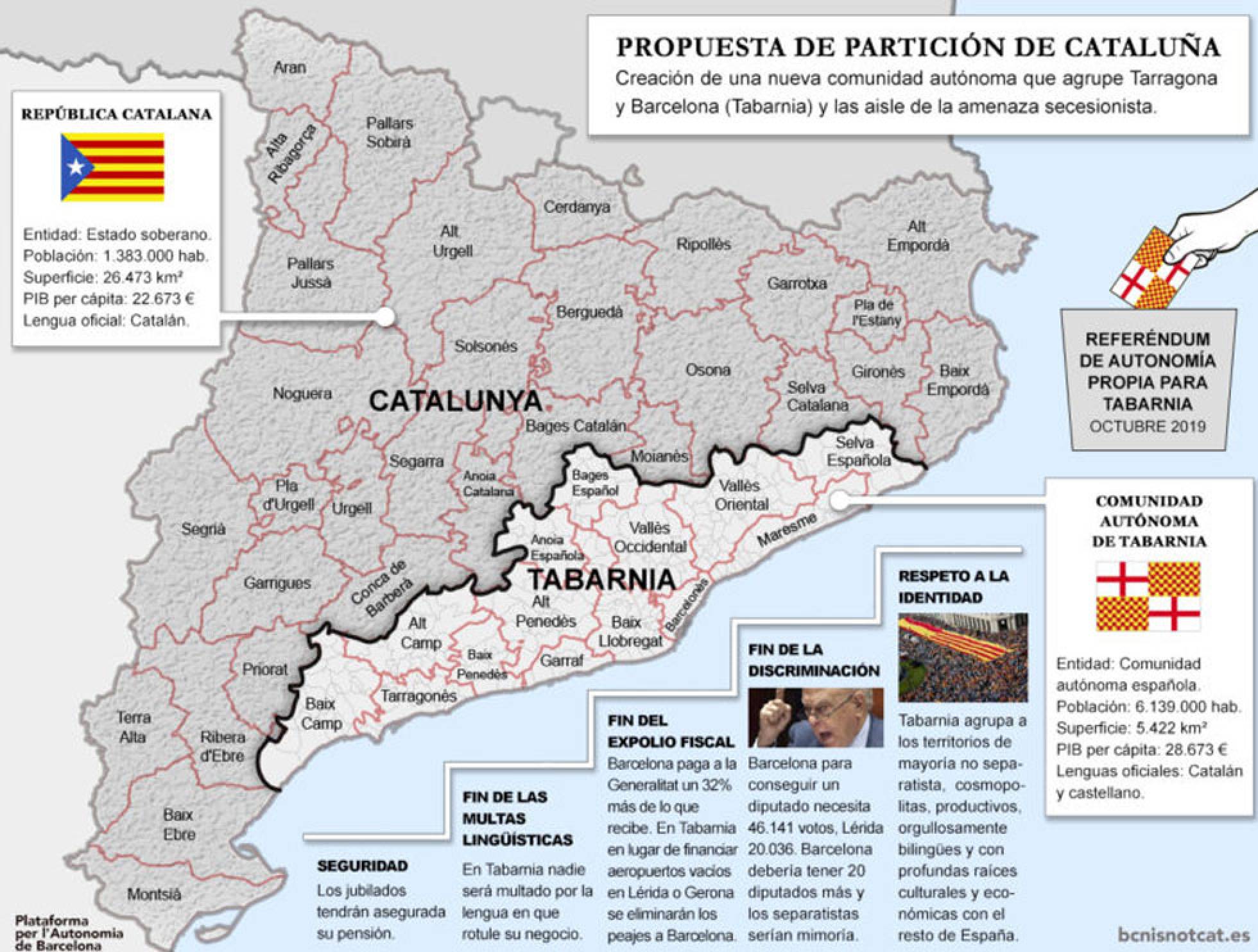Could Barcelona and Tarragona become independent from the rest of Catalonia? This is what some unionists have been asking themselves these days following the results of the Catalan election, which reaffirms the pro-independence majority in the Catalan Parliament. The solution, for some, could be to create a new Spanish autonomous community, Tabarnia, which would consist of the areas in Catalonia with most unionist votes.
The concept is not new. As a matter of fact, it has existed since 2012, but after the so-called ‘silent majority’ that some had hoped for did not emerge on 21st December and the unionists failed to beat the independence movement at the ballot box, the suggestion has arisen again among those supporting continued union with Spain. In fact, on Tuesday the term became a worldwide trending topic on Twitter, with more than 160,000 tweets, and Spanish media as well as political parties like the Citizens (Cs), took up the idea as a way of undermining the Catalan independence movement.
Tabarnia is a neologism formed from the place names Barcelona and Tarragona which, according to its proponents, is made up of the regions where the unionist parties won the Catalan elections: from the Maresme, the coastal county north of Barcelona, as far as south along the coast as the Baix Camp, beyond Tarragona. Behind the initiative is the platform Barcelona is not Catalonia, which created a petition on the Change.org website to ask the Spanish Congress for a referendum on the creation of this new Spanish region. A petition that already has more than 25,500 signatures.
However, this idea from unionist forces is not supported by the reality of the Catalan election results. Not all the areas included in the hypothetical Tabarnia voted for unionist parties and, moreover, in some large cities, traditionally considered strongholds of pro-Spanish support, the vote in favour of independence actually grew.
An unreal map
The Tabarnia drawn by unionism would consist of ten Catalan counties: Tarragonès, Baix Camp, Alt Penedès, Baix Penedès, Garraf, Baix Llobregat, Barcelonès, Vallès Oriental, Vallès Occidental and Maresme. According to the idea's sponsors, these are the regions where the "155" block finished ahead of the pro-independence block in the election. But was it really so?
#Tabarnia es una realidad por mucho que los medios separatistas lo oculten. Tabarnia es distinta y vota distinto. Referéndum de autonomía para Tabarnia YA! #Tabarnexit #Barcelona #Ciutadans #Bcn #Tarragona #Bcnisnotcat pic.twitter.com/VdQmU7vsSG
— Bcnisnotcat (@Bcnisnotcat_) 22 of diciembre of 2017
Translation: Tabarnia is a reality no matter how much the pro-independence media hides the fact. Tabarnia is different and votes differently. Referendum for an autonomous community NOW!
In fact, only six of the ten counties included were won by the unionists; three of those with more than 50% of the votes (Tarragonès, Baix Penedès and Baix Llobregat), while in the remaining three, this threshold was not reached (Barcelonès, Garraf and Vallès Occidental). By contrast, in the other four counties - Maresme, Alt Penedès, Vallès Oriental and Baix Camp - the victory went to the pro-independence block.
Thus, the Catalan sovereignist block prevailed in Alt Penedès with 55.6% of the votes and in the Maresme with 53.78%, while in the Baix Camp and Vallès Oriental the pro-independence parties obtained less than 50% of support, but still exceeded the vote for the ‘155 block’, since the rest of the votes were for the Catalonia in Common - Podem group (which refuses to be positioned in either pro- or anti-independence blocks).
Although it is true that in some of these areas Cs were the largest party on election day, the unionist parties as a whole did not finish ahead of the opposing block. This is the case in Baix Camp and Vallès Oriental, where Cs was the most voted force, but the 155 parties were defeated by the independence parties. However, in the case of Alt Penedès and the Maresme, neither unionism as a whole nor the Cs as the largest list triumphed. Both of these areas within metropolitan Barcelona were won by Carles Puigdemont's Together for Catalonia (JxCAT) list, and the overall independence block vote exceeded 50% of the total.
The most symbolic case is that of the municipality of Barcelona itself. Although Cs was the largest force in the Catalan capital with 23.94% of votes, the three pro-republican candidatures won overall, with 45.78% of the count, versus the 43.47% of the three constitutionalist forces.
Moreover, an even more extensive map of Tabàrnia, also promoted by the Barcelona is not Catalonia platform, also includes other regions such as Alt Camp, where the independence parties won with more than 61%, and parts of Selva, Bages and Anoia counties, which would under this supposition be divided between the "Spanish" and "Catalan" zones.

Independence support growing in unionist strongholds
Not only is the Tabarnia map unreal, but as well the 21st December elections served to destroy another of the widespread myths (in addition to the idea that abstentionists in previous elections had been unionists): it is in Tabarnia that the pro-independence vote has undergone its most notable growth. Of the 100,000 extra pro-independence votes won since the 2015 elections, 65,883 were voters in the Barcelona province and 13,767 in Tarragona.
In the case of Tarragona province, the independence vote also grew in percentage in spite of the increased voter turnout, going from 49.02% to 49.5%. However, the sum of Citizens, the Catalan Socialists (PSC) and the Popular Party (PP) only amounted to 43.67% of the ballots. In Girona province, the pro-republican alliance went backwards almost a full percentage point (-0.94%).
This trend was also observed in the country's main cities. In several towns in the Barcelona metropolitan area, traditional fiefdoms of the unionist parties, the pro-independence movement grew in both absolute votes and percentage with respect to the 2015 elections. This was the case in Badalona (+1.67%), Cornellà de Llobregat (+1.55%), l'Hospitalet de Llobregat (0.95%), El Prat de Llobregat (+1.7%) and Sant Vicenç dels Horts (+1.47%). The most extreme case was Badia del Vallès, the Catalan town which gives least support to independence, where, despite that distinction, support for secession rose 3.74 points, from 14.6% to 18.34%.
On the other hand, it is in the independence movements' main centres of strength that it has regressed most. In Manresa, the pro-independence parties slipped back 0.21%, and in Girona they fell by 0.59%. Other falls were Vilafranca del Penedès (-0.88%), Vic (-1.39%), Igualada (-1.53%) while in Figueres the fall was a full two points.
Setting the agenda
Sometimes the agenda portrayed by the mass media is highly influenced by their social and political environment, but in other cases, the media themselves are able to create an agenda by exercising their power. This is the theory of agenda-setting, which hypothesises that the mass media can use their huge power over users to determine which issues are perceived as important. This seems to be very much the case with the emergence of the Tabarnia idea. Overnight, the major Spanish media have started talking about this concept, as a way of emphasising the idea of social fracture in Catalonia.
Given resonance to the Twitter initiative, the Spanish newspaper El País assures that "the analysis of the Catalan election results shows much higher support for Catalan independence in the provinces of Girona and Lleida than in Barcelona and Tarragona", and that "the difference in support is almost 20 percentage points between Barcelona and Girona". The news site 20minutos.es even goes so far as to speak of "the area of Barcelona and Tarragona which does not want to be part of Catalonia".
Meanwhile, Libertad Digital points out that the most pro-independence part of Catalonia is the "most rural" and claims that: "The arguments of those in favour of Tabarnia start from realities which the Catalan independence movement hides, for example that a vote by a Barcelona resident has half the value of a vote in the most pro-independence areas".
As well as the leading Spanish media, the two main newspapers edited in Barcelona, La Vanguardia and El Periódico, have also nourished the debate.
But it is not only the media who have stirred the pot with this idea: some unionist politicians have entered the fray as well. Starting with the highest polling list on 21st December, Cs, whose candidate Inés Arrimadas shared an article asking "What is Tabarnia?" on her Twitter account:
El nacionalismo defiende una Cataluña homogénea y choca fácilmente contra sus propias contradicciones. Defendemos una Cataluña dentro de España y la UE donde se respete y se entienda la pluralidad y diversidad ¿Qué es Tabarnia? https://t.co/XjArp52WTD
— Inés Arrimadas (@InesArrimadas) 26 of diciembre of 2017
Translation: "Nationalism defends a homogeneous Catalonia and easily collides against its own contradictions. We defend a Catalonia within Spain and the EU where plurality and diversity are respected and understood." - Inés Arrimadas
Lo de Tabarnia es una ocurrencia que pone al independentismo ante el espejo de sus propias contradicciones y de la fragilidad de sus argumentos. Es muy significativo lo nerviosos que se han puesto algunos
— Inés Arrimadas (@InesArrimadas) 26 of December 2017
The Tabarnia idea hold a mirror up to the independence movement and reveals its contradictions and the fragility of its arguments. It is very significant how much this has worried some people — Inés Arrimadas
Cs leader Albert Rivera took a similiar line, using the unreal, invented map:
Si los nacionalistas alegan el inexistente derecho a dividir, cualquiera puede hacerlo. Prefiero diversidad y unión. https://t.co/sHEn2ZL2oF
— Albert Rivera (@Albert_Rivera) 26 of diciembre of 2017
If the nationalists proclaim the non-existent right to decide, anyone can do the same. I prefer diversity and union. — Albert Rivera
Rivera's number two in the Spanish Congress, Juan Carlos Girauta, shared a post from the far-right website Dolça Catalunya: "Tabarnia yes: this is the moment to redraw the county lines of Catalonia". The post he links to includes offerings such as the following: "There is a hard-working Catalonia, free of nationalism that finances the woolly Catalonia, and on top of that, has less power of decision".
Tabarnia sí: és el moment de descomarcalitzar Catalunya https://t.co/RzUmE01UXm vía @DolcaCatalunya — Juan Carlos Girauta (@GirautaOficial) 24 of diciembre of 2017
The real Tabarnia
If we take the real results of the Catalan election, and map the duel between the pro-independence block and unionist block in all the municipalities of Catalonia, the map that appears is quite different from the one being publicised by the unionists.

